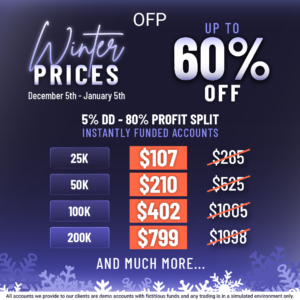The role of automated trading in prop challenges has increasingly become significant. Prop firms are using automated trading systems more and more to improve their tactics and streamline operations in the fast-paced world of trading. Automated trading has many benefits, but it also brings with it special difficulties that firms must overcome if they want to stay profitable and competitive. The role of automated trading in prop challenges will be examined in this article, along with its advantages and disadvantages.
What Is Automatic Trading
Automated trading has to do with the use of computer algorithms to carry out trades on behalf of a trader or firm. These systems can analyze market conditions, carry out orders, and function based on predetermined criteria without the need for human participation. Several asset classes, such as stocks, options, futures, and FX, can be traded automatically.
The Development of Prop Firm Automated Trading
Many prop firms have adopted automated trading in order to take advantage of market opportunities more effectively as technology advances. Traders can manage many strategies at once, which lessens the emotional strain that comes with manual trading because automated systems are fast and accurate. The way prop firms function and compete in the financial markets has changed as a result of this move towards automation.
Benefits of Automated Trading for Prop Firms
1. Enhanced Productivity
Execution Speed
- Automated trading systems enable firms to take advantage of short-lived market opportunities by executing trades in a matter of milliseconds. In high-frequency trading environments, where delays can lead to missing gains, this speed is critical.
Constant Trading Capability
- Because automated systems are always running, firms can transact across time zones without constant human supervision. This feature guarantees that traders can take advantage of changes in the world market while they are asleep.
2. Improved Information Extraction
Sophisticated Algorithms
- Large volumes of data may be quickly analyzed by automated trading systems, which can then spot patterns and trends that human traders might miss. Making decisions based on facts makes them more informed.
Optimization and Backtesting
- Prop firms can assess the efficacy of their automated techniques by backtesting them against previous data. This procedure lowers the chance of loss by optimizing strategies before implementing them in active markets.
3. Trading Without Feeling
Reliability in Performance
- Handling emotions is one of the biggest problems for manual traders, especially in erratic market conditions. Emotional prejudices are removed by automated trading systems, guaranteeing that trades are carried out in accordance with predetermined standards.
Adherence to a disciplined strategy
- Traders that rely on algorithms are less likely to adjust their strategy in reaction to changes in the market. Over time, this dedication may result in more reliable performance.
4. Ability to Scale
Handling Several Approaches
- Prop firms are able to handle several trading methods at once because of automated technology. Due to its capacity to scale, this feature can boost overall profitability by spreading risk over a wider range of strategies and assets.
Allocating Resources
- Traders can concentrate on developing and analyzing higher-level strategies, as regular activities are handled by automation. This change in resource distribution raises overall productivity within the firm.
Automated Trading’s Difficulties in Prop Firms
Although automated trading has many benefits, it also presents several issues that prop firms need to deal with.
System Errors
- Automated trading systems can experience technical difficulties including network problems or software faults. These mistakes might result in inadvertent trades or lost trading opportunities, which can have serious financial consequences.
Issues with Data Quality
- Data quality is highly dependent on automated systems. Trading decisions may be flawed as a result of incomplete or delayed data. Prop firms need to make sure they employ dependable data streams and uphold strong data management procedures.
2. Over Optimization
Fitting Curves
- Traders may over-optimize their algorithms based on historical data in their quest for perfection, a practice known as curve fitting. This may result in techniques that work well during backtesting but not during actual trading because of unanticipated circumstances or changes in the market.
Insufficient Flexibility
- Automated strategies could find it difficult to adjust to shifting market conditions. A firm runs the danger of missing important market signals if it depends too much on automated systems without including human monitoring.
3. Regulatory Difficulties
Compliance Standards
- The rise of automated trading has led to heightened regulatory scrutiny. Prop firms have to manage intricate compliance procedures to make sure that their trading systems meet legal regulations. Penalties for noncompliance might be quite severe.
Fears of Market Manipulation
- Automated trading can sometimes lead to practices that regulators deem manipulative, such as quote stuffing or layering. Prop firms need to put safety measures in place to make sure their systems run within the law.
4. Human Oversight
Technology Dependence
- Automation can be efficient, but relying too much on technology can have negative effects. In order to guarantee that tactics stay current and efficient, traders need to strike a balance between automation and human control.
Deficit in Skills
- The need for qualified experts who can create, oversee, and debug these technologies is rising as more firms implement automated systems. This disparity in skills may make it difficult to find and keep talent.
Best Practices For Putting Automated Trading Into Practice
Prop firms can use the following best practices to help them deal with the difficulties posed by automated trading:
1. Strict Validation and Testing
- Firms should perform thorough backtesting and forward testing prior to implementing automated strategies. Stress testing should be a part of this procedure to assess the system’s performance in different market scenarios.
2. Ongoing Assessment and Observation
- To make sure automated trading systems are operating as intended, they should be constantly observed. Frequent reviews can assist in pinpointing areas in need of development and averting any problems before they get out of hand.
3. Stressing Human Involvement
- Although automation can increase productivity, human supervision is still necessary. Traders must periodically examine automated trades and modify their approaches in response to evolving market circumstances and insights.
4. Risk and Compliance
- Prioritizing regulatory compliance and putting strong risk management procedures in place are two things that firms must do. This entails setting precise rules for automated trading operations and making certain that all systems follow them.
5. Training and Education
- Bridging the skills gap for traders requires investing in their education and training. Continuing education in trading tactics and technology will enable traders to make efficient use of automated systems.
Summary
Automated trading has altered the way prop firms function, delivering higher efficiency, enhanced data analysis, and emotional discipline. But there are also a lot of difficulties with it, such as over-optimization, regulatory issues, and technical hazards. Prop firms may take advantage of automated trading’s potential benefits while reducing its dangers by implementing best practices and striking a balance between automation and human monitoring.
The significance of automated trading is expected to increase as the trading environment develops further. Prop firms that effectively handle the automation-related obstacles will improve their trading tactics and get a competitive advantage in the quick-moving financial markets. In the end, trading’s future depends on achieving the ideal balance between technological advancement and human skill, which will enable firms to flourish in a constantly shifting market.
Frequently Asked Questions
1. What is automated trading?
- The term “automated trading” describes the process of executing trades automatically using computer algorithms in accordance with preset parameters, doing away with the necessity for human interaction.
2. How do prop firms benefit from automated trading?
- Benefits of automated trading include improved data analysis, quicker execution times, higher efficiency, and the capacity to manage several strategies at once.
3. What dangers come with trading automatically?
- Technical malfunctions, problems with data integrity, over-optimization of tactics, difficulties with regulations, and the possibility of inadequate human supervision are among the risks.
4. How are data quality standards for automated trading met by prop firms?
- Prop firms make sure that the data in their trading systems is accurate by using dependable data feeds, performing frequent audits, and upholding strong data management procedures.
5. In automated trading, what does over-optimization mean?
- Curve fitting, also known as over-optimization, is the process of over-refinement of a trading strategy based on past data, which results in subpar performance in real markets.
6. Are automated trading practices subject to regulatory concerns?
- Indeed, there has been a greater focus on regulations as automated trading has grown in popularity. To avoid fines, prop companies need to make sure that all regulations are followed.
7. How do prop firms strike a balance between human monitoring and automation?
- By regularly monitoring automated systems, carrying out reviews on a regular basis, and permitting traders to modify their tactics as necessary, firms can strike a balance between automation and human oversight.
8. When it comes to automated trading, what standard practices should prop firms adhere to?
- Robust testing and validation, ongoing observation, prioritizing human supervision, adhering to rules, and funding trader education are examples of best practices.


















